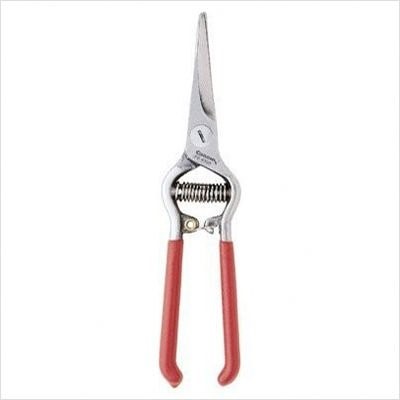
Thinning Shears–Practically Perfect Pruner
I had 13 hand pruners . . until I brought a lot of them to the Tools and Treasures table. What is surprising is that I only used one of them 95% of the time. The Corona Thinning Shear is the one tool that really makes me panic when I lose it some place in the garden. It is small enough to hide in mulch or in a pile of clippings. But smallness is one of its attributes. I imagine that most of you garden with your pants on. By that I mean you wear pants with pockets. The slender profile of the pruner allows you slip in your rear pocket. It doesn’t stick out far and catch on anything. The blade tips are rounded so there is no danger of immediately creating a hole in your pocket or tender parts. The other feature that makes this a “must have” for me is the fact that the cutting blades are long and thin. You can reach into tight spaces. Cuts can be made close to an adjoining stem. Yet the blades are strong enough to cut through thick plant material. I have to admit that I also occasionally use it closed as a weeding tool particularly between pavers. Also with closed blades you can jam it into the soil to loosen a stubborn weed. Although it’s hard on the cutting edges, this is the best tool I have for cutting off oak tree seedlings beneath the soil. Fortunately the straight blades are easy to sharpen. I use this “thinning shear” to clean up cannas, prune grape vines, gingerly trim quince, cut back new growth on cherry and plum trees, and even prune the roses. Yeah, I know I should use a knife edge bypass pruner, but this practically perfect pruner is already in my back pocket so that is what gets used. OK, why isn’t it absolutely perfect? If dried plant juices build up on the blades, the blades will start to stick. Use either oven cleaner, WD-40, or carefully sandpaper the inner surfaces to remove the buildup. You also have to remember this is a light weight pruner. It will not cut through a hard, woody stem generally thicker than ¼ inch. It’s at this point that I bypass the bypass hand pruners and reach for a lopper. I love my thinning shear. I feel it is a “must have” in your arsenal of garden weapons.
Convinced? This tool is available at Amazon as FS-4350 Thinning Shear and, wisely so, is Amazon’s Choice at less than $20.
P.S. If you are looking for an entertaining activity at a party, this pruner is invaluable. Stun you guests with the disappearing pruner trick like I showed you when I deftly slipped the pruner into my back pocket. You can create a contest by seeing which guest can perform this trick the fastest. (It would be sad if you thought for a moment that I was serious.)
I hope you’re not a dead horse. I cannot help but to continue to work on you to buy a thinning pruner. In the last two days I have used mine to cut out the dead woodwardia fronds, to trim back a grape ivy in a hanging basket, to prune lightly forsythia and the yesterday, today, and tomorrow, to cut back the flowering quince and to dead head canna. Finally this morning I tackled the grape vines on the pergola in the back yard. Every year at this time I have to remove all the moldy grapes that have developed. Poor air circulation ruins the crop each year. I have to climb a ladder and reach up through 2 x 4’s to cut grapes out. I suddenly realized why I treasure my pruner. It increases your reach. It’s like reaching out with a pair of scissors. So if you have light pruning to do, or pruning that requires reaching between thorns, objects, or other branches, this thinning shear is for you. It is not for pruning roses and it will not cut woody stems much larger than ¼ inch, but if your garden is anything like mine, there are almost endless uses for this great tool. And, remember how easily it fits in you back pocket?
Once again, it’s available on Amazon—Corona FS-4350 Thinning Shears.
Happy Pruning, Stan

4350 thinning shears
